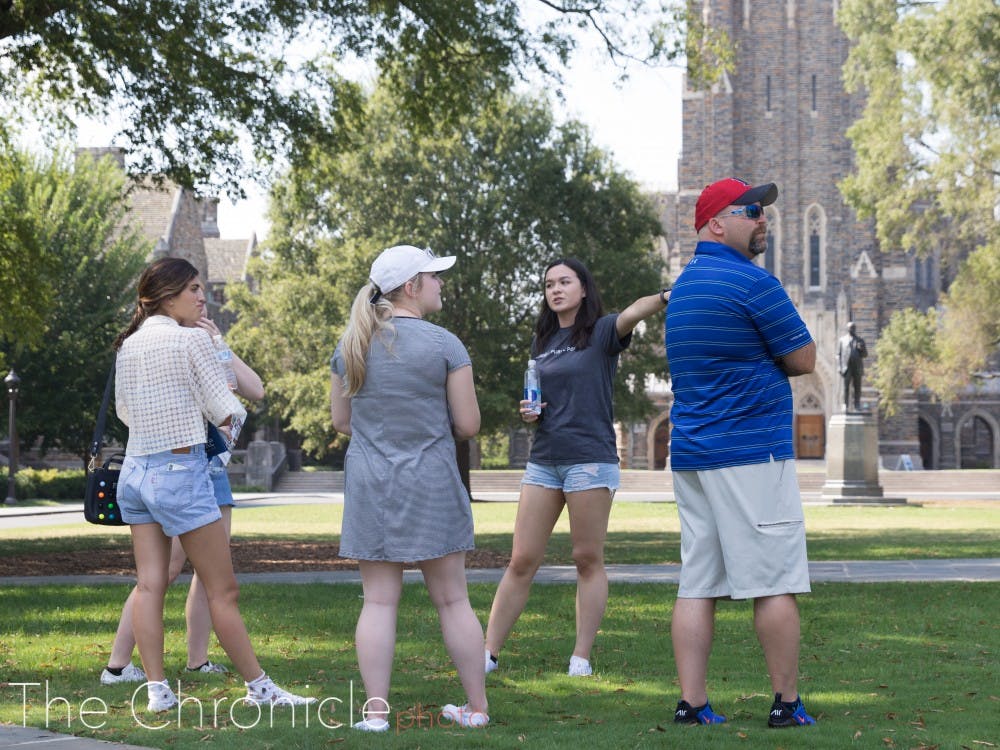Living in a tent for several months in sub-freezing temperatures is not the only way that Duke students show their unwavering school spirit—some become tour guides.
Hundreds of students choose to partake in this process each year for the chance to represent Duke. Sophomore Dan Garcia said that the commitment “takes a lot of love for the school,” as guides serve as representatives for the University.
However, many tour guides struggle with authenticity during their tours, several guides told The Chronicle, especially with visitors curious about the more negative aspects of the school.
At Duke, tours take place rain or shine. Guides must speak at a clearly audible volume and remain enthusiastic—or at least maintain a facade of enthusiasm—for 90 minutes regardless of how their groups may behave or react.
“There are definitely things at Duke that might deter students from applying or coming to campus that I am not allowed to address,” sophomore Alice Zhou wrote in an email to The Chronicle.
Sophomore Jeffrey Zheng explained that the tour guide position occupies an interesting middle ground.
“The tour guide program is somewhat strange in that it’s both a student group and linked to Duke administration,” he said.
Cole Wicker, Trinity ‘18 and an admissions officer who advises the tour guide system, said that there are only a couple blanket off-limits topics for guides. These include negative comments about other schools and the details of admissions practices, since they’re not admissions officers.
And even when the academic year ends, prospective students still flock to campus for tours during the summer.
Garcia noted that although summer tour guides have certain benefits over semester guides—namely financial compensation and a less rigorous application process—their tours are often more demanding. With fewer Duke students on campus and more prospective applicants visiting, summer tour guides sometimes give upward of two or three tours per day in the Durham heat.
Some additional complexities can also arise on a case-by-case basis.
For example, Zhou did not attend high school in the United States, a fact she said she includes when introducing herself to visitors. Because of this, Zhou found that people would sometimes assume she was not fluent in English or would ask about the international student experience—a subject that Zhou, as a U.S. citizen, feels unequipped to fully address.
“Tour guide introductions are usually less than a minute, and visitors have to choose a tour guide based on these brief snippets,” Zhou wrote. “I think it’s inevitable that some people will make assumptions about my identity.”
Wicker acknowledged the brevity of these introductions, but explained that they were necessary with 10 or more tour guides leading each tour. But even so, guides are by no means restricted from divulging other aspects of their identity, whether in their introductions or during the tour, he explained.
Zheng added that the tour guide’s major also plays a large role in shaping the experience. Naturally, visitors gravitate toward those with similar interests, often creating disproportionately sized groups.
“When tour groups hear that a tour guide is pre-med, you’ll see huge groups of people flock to that person,” Zheng said.
Meanwhile, he added that the less popular majors—often times arts and humanities majors—either attract much smaller crowds or are not represented by a tour guide at all.
Despite these challenges, however, the tour guide system does allow considerable freedom to engage with visitors as they best see fit, and Garcia said that flexibility is one of the greatest characteristics a tour guide could have.
“Tours are not as scripted as people think,” he explained. “You don’t want to sound like an audio cassette. You want to be a human being who can notice different things everyday.”
Furthermore, the tour guide manual states that “the three most important words in a tour guide’s vocabulary are ‘I DON’T KNOW.’” Even after several months of training, tour guides are not expected to have all of the answers, and the manual encourages directing visitors to other better-informed sources.
Get The Chronicle straight to your inbox
Sign up for our weekly newsletter. Cancel at any time.
These freedoms do not just intend to benefit visitors who may be considering applying to Duke, but they also take some pressure off of guides as well.
In any case, however, the majority of Duke’s tour guides find that their work is well-worth whatever it may take. To become a Duke tour guide, students must take an exam on a 26-page tour guide manual, after which they may be considered for an interview. If selected to continue, they undergo an extensive training process for half a semester. Interspersed between these are informational sessions that outline routes, acceptable behaviors and general advice.
Students become tour guides voluntarily and the large majority continue with the system even once they have realized the demands.
“I love being a tour guide—especially being able to tell my own stories and not just numbers,” Garcia said.
For Zhou, the investment of being a tour guide is not necessarily based wholly in her love for Duke but in her hope for its future.
“I’m always super excited because all these really amazing or interesting students want to come to Duke,” she wrote. “Knowing that some of the people you’ve just given a tour to may end up on campus in the next couple of years is really cool to think about.”

